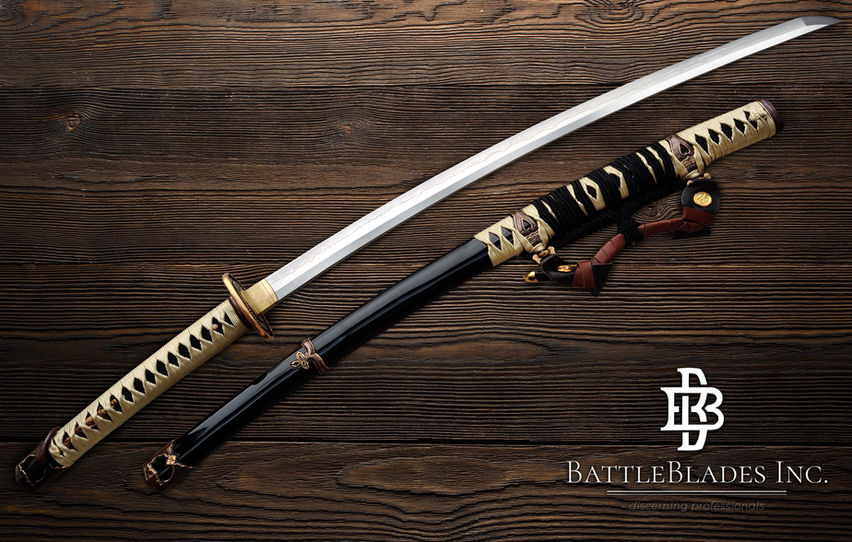

KAZARI TACHI
MSRP € 1699
During the Heian period (794-1185), Japanese swordsmiths began to develop differently tempered and curved blades better for slicing, replacing the preceding blades designed for hacking and stabbing. This resulted in the creation of the first japanese sword with a curved blade, the tachi. Tachi is a traditional Japanese sword with sabre-like qualities, worn by the high-ranking samurai in the Kotō period (900-1596). It is known to be the predecessor of the developement of the katana, which were popularized almost 300 years later. In the Kotō period, the samurai working for the emperor were the only ones allowed to carry tachi and ride horses in battle, so even after the Muromachi period (1336–1573), when katanas became the mainstream sword, tachi was still often worn by high-ranking samurai, to pay homage to its history. For 700 years through the Kotō period, the samurai always paired their lengthy tachi with a shorter sword, an uchigatana or wakizashi. Due to the changes in fighting style during the Edo period (1603–1868), when guns, spears and bows became main weapons of warfare, the samurai started to replace their tachi of the daishō with a more lightweight katana.
The tachi has a deeper degree of curvature and a slightly longer blade than a katana, which benefitted the feudal samurai fighting on horseback, as the curved blade adds significant downward force when cutting. The length of the nagasa varied throughout the periods, but was later officially fixed between 44 to 80 centimeters. An authentic tachi is heftier compared to a katana, but is generally lighter in proportion to its length, has a greater taper from hilt to point and a smaller point area for penetrating heavy clothing. Unlike a traditional katana, tachi is carried on the belt blade down for faster wielding and slashing. The carrying system on the saya consists of ashi (suspension loops), and obitori (cord) usually made of leather or silk. The obitori is used to attach the tachi to the obi (belt) and the tachio is wrapped around the waist to further stabilize the saya. The tsuka typically follows the curvature of the nagasa and is made of rayskin covered hardwood and is most often hinerimaki wrapped. Morozori tsuka was most commonly used in tachi swords, but here is no set shape of tsuka for a tachi, as it changed a lot troughout the different periods. Despite all the changes, the characteristic mountings on tsuka and saya, stayed in fashion. These mountings are called kabuto-gane (hilt cap), semegane (scabbard ring) and saya-jiri (scabbard tip).
Every detail of the Kazari Tachi is carefully chosen to highlight tachi's distinctive characteristics. The honsanmai laminated 1095 steel nagasa has a very deep koshi-zori curve, and is much wider than any of our previous swords' nagasa. For example, compared to Zugaikotsu Honsanmai Shinken's blade, Kazari Tachi's is almost one centimetre wider by the tsuba. Using the honsanmai lamination together with this blade geometry resulted one of the most beautiful and showy blades we have ever designed. The folded layers are very visible throughout the whole blade, giving it almost a wood grain looking finish The morozori shaped tsuka, which tapers towards the kabuto-gane, is shaped to be a continuation of the deep nagasa sori.
We took some inspiration from our Kogane series and implimented it in the materials. The hardwood tsuka is covered with black rayskin and wrapped in golden silk rope, using hinerimaki style to ensure maximum grip. The black and gold color scheme continues gracefully to the oval tsuba, embellished with a golden edge and a golden chrysanthemum-like flower pattern in the middle. The kabuto-gane, the sarute (ring hanging from kabuto-gane), fuchi and tsuba, are all made of antique finished copper. Brass seppa plates and habaki secure the gorgeous tsuba in it's place. The tsuka is further decorated with two brass fish menuki traditional to tachi.
The black-lacquered hardwood saya has a golden silk itomaki no tachi (saya wrapping) to give the sword a classy look. There are two leather ashi for hanging the Kazari Tachi on the belt, but it can also be carried separately by the leather obitori or wrapped around the waist using the black silk tachio/sageo. The saya-guchi, saya-jiri and semegane-mono are made of antique finished copper. We recommend pairing the Kazari Tachi with our Kogane no Senshi Honsanmai Wakizashi, to create your own Kotō period inspired daishō.
To get your hands on this piece of art - order from our dealers!
Read more about 1095 steel and katana parts.
/ BB-KT
SPECIFICATIONS OF KAZARI TACHI
OVERALL LENGTH
3.35 Shaku / 101.5 cm / 39.96 in
NAGASA
2.42 Shaku / 73.3 cm / 28.86 in
TSUKA
0.91 shaku / 27.5 cm / 10.83 in
KASANE
8.0 mm / 0.31 in
SAKIKASANE
5.0 mm / 0.2 in
MOTOHABA
3.3 cm / 1.29 in
SAKIHABA
2.3 cm / 0.91 in
NAGASA MATERIAL
clay tempered hand forged 1095 Honsanmai steel
WEIGHT
1.24 kg / 2.73 lbs (without saya)
1.78 kg / 3.92 lbs (with saya)


